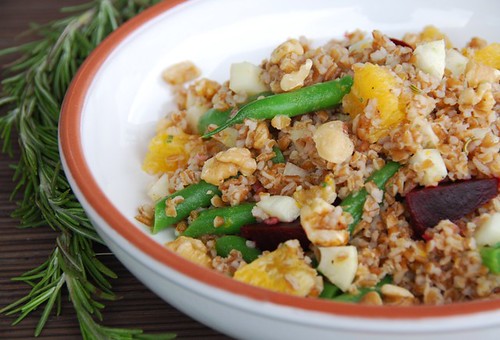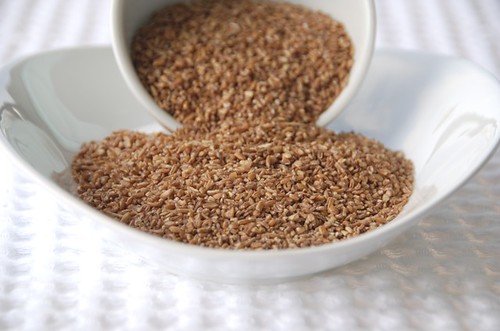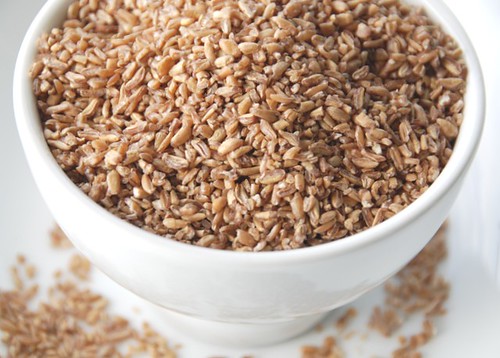
So you call yourself a foodie, huh?
OK, quick, how many whole grains can you name in 1 minute?

Time's up!
- If you named zero
- You're probably still eating Fruit Loops for breakfast and need to acquaint yourself with Kashi (no, it's not a country in Middle East).
- If you named 1-5
- You're actually reading your cooking magazines instead of just using them for coasters. Good for you!
- If you named 6-10
- Then you likely have posters of all the Iron Chefs in your bedroom.
- If you named 11 or more
- Then you either just Googled "whole grains" or you are a true smarty-pants and find you sometimes have difficulty getting along with others.
- amaranth
- barley
- buckwheat
- bulgur
- corn
- farro
- grano
- kamut
- millet
- oats
- quinoa (keen-wa)
- rice
- rye
- sorghum/milo
- spelt
- teff
- triticale (trit-i-kay-lee)
- wheat
- wild rice
So why should you eat whole grains?
- They contain complex carbs, which your body digests more slowly, keeping you satiated longer.
- They are associated with a decreased risk of cardiovascular disease, diabetes, and stroke.
- They contain beneficial vitamins and are high in calcium, which is needed to build strong bones.
- They taste great.

When purchasing bulgur, buy those packages labeled either "bulgur" or "bulgur wheat." (It might also be spelled "bulghur.") Do not however buy "cracked wheat" which has not been parboiled and takes much longer to cook. I learned that the hard way.
 This dish has a number of calcium-rich ingredients: bulgur, fennel, oranges, string beans, chick peas, nuts, and rosemary. Earthy beets, licorice-scented fennel, and sweet oranges, are enhanced by a warm and tangy fennel-honey-mustard vinaigrette. And it tastes even better the next day.
This dish has a number of calcium-rich ingredients: bulgur, fennel, oranges, string beans, chick peas, nuts, and rosemary. Earthy beets, licorice-scented fennel, and sweet oranges, are enhanced by a warm and tangy fennel-honey-mustard vinaigrette. And it tastes even better the next day.Would you like to participate in Beautiful Bones? You have until May 31st; the details are here.

Warm Bulgur Salad with Beets, Fennel, and Oranges
Serves 4
Print recipe only here.
Salad:
1 cup uncooked medium coarse bulgur wheat
4 small beets, roasted and sliced
1 cup sliced green beans
1/2 cup diced fennel bulb
2 medium navel oranges, peeled, sectioned, and chopped
1 (15 oz.) can chickpeas, rinsed and drained
2 tablespoons toasted walnuts, pecans, or pistachios
Warm Fennel-Honey-Mustard Vinaigrette:
1/2 teaspoon fennel seeds, toasted
2 tablespoons olive oil
2 tablespoons red wine vinegar
1/2 cup freshly squeezed orange juice (or from a carton)
1/2 teaspoon orange zest
2 teaspoons Dijon mustard
2 teaspoons honey
2 teaspoons water
1/2 teaspoon minced fresh rosemary
salt and freshly ground black pepper, to taste
Cut off beet tops, and clean beets. (If you’re keeping the beet greens; submerge in cool water to release any dirt, then drain. Par-boil the greens by dropping them in boiling water for about 1 minute; remove and plunge into a bowl of ice water.) Shocking the greens like this will maintain their vibrant color. Drain, and store in an air-tight container in the refrigerator.
Meanwhile boil the string beans for 2-3 minutes, then plunge into a bowl of ice water. Drain and slice into 1-inch long pieces. Chop fennel and slice oranges; set aside.
To toast the walnuts, place in a small, dry skillet over medium. Shake pan handle to ensure even toasting, for 1-2 minutes or until slightly toasted and aromatic.
To make the vinaigrette, place anise seeds in a small, dry skillet over medium. Shake pan handle to ensure even toasting, for 1-2 minutes or until slightly toasted and aromatic. Add all other ingredients to skillet and keep over a low heat for about 1-2 minutes, whisking until well emulsified. Remove from heat and set aside.
In a large bowl, toss together the cooked bulgur, vegetables, oranges, chickpeas, and nuts. Drizzle the dressing over the salad and toss gently until well coated. Sprinkle individual servings with toasted nuts and extra fresh minced rosemary, if desired.You might also like:
 Breakfast Quinoa with Dried Cherries, Raisins, and Pecans
Breakfast Quinoa with Dried Cherries, Raisins, and Pecans Baby Artichoke and Asparagus Risotto
Baby Artichoke and Asparagus Risotto Italian Easter Rice Pie (though it's delicious 12 months of the year!)
Italian Easter Rice Pie (though it's delicious 12 months of the year!)